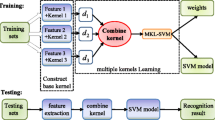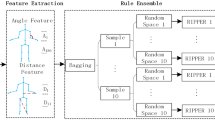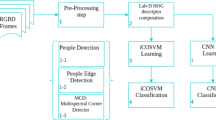Abstract
The learner’s body posture reflects the learner’s learning state. The learner’s posture recognition can effectively evaluate their learning state, which plays an important role in the teacher’s teaching process. In this paper, a new method for learner’s gesture recognition is proposed, which fuses the improved scale invariant local ternary pattern (SILTP) and the local directional pattern (LDP). Firstly, a multi-scale weighted adaptive SILTP (MWA-SILTP) algorithm is proposed. The dynamic threshold of the current neighborhood is adaptively generated according to the dispersion degree of contrast values in global and local neighborhoods, and SILTP coding is carried out to obtain adaptive SILTP. And the concept of multi-scale is introduced. By changing the sampling radius, the adaptive SILTPs of different scales are obtained. The adaptive SILTPs of different scales are merged with different weights to represent the image in multi-resolution. The MWA-SILTP algorithm is used to extract the feature of the learner’s posture image. Secondly, the LDP algorithm is used to extract the feature of the learner’s posture image. Finally, the two features are merged, and the support vector machine is used for classification and recognition. The improved SILTP can get more feature information and has stronger adaptability. The LDP algorithm has advantages in anti-interference and can extract edge information better. The fusing model of this paper fully utilizes the advantages of the two algorithms. Experimental results show that the proposed method can effectively recognize learner’s posture of sitting, raising hand and lowering head.





Similar content being viewed by others
References
Choi SI, Lee SS, Choi ST, Shin WY (2018) Face recognition using composite features based on discriminant analysis. IEEE Access 6:13663–13670
Chu H, Qi M, Liu H, Jiang J (2017) Local region partition for person re-identification. Multimed Tools Appl:1–17
Guo M, Hou X, Ma Y, Wu X (2017) Facial expression recognition using ELBP based on covariance matrix transform in KLT. Multimed Tools Appl 76(2):2995–3010
Hu MC, Ng KS, Chen PY, Hsiao YJ, Li CH (2018) Local binary pattern circuit generator with adjustable parameters for feature extraction. IEEE Trans Intell Transp Syst 19(8):2582–2591
Ji L, Ren Y, Liu G, Pu X (2018) Training-based gradient LBP feature models for multiresolution texture classification. IEEE Transactions on Cybernetics 48(9):2683–2696
Ji Z, Wang W (2014) Detect foreground objects via adaptive fusing model in a hybrid feature space. Pattern Recogn 47(9):2952–2961
Lenc L, Král P (2016) Local binary pattern based face recognition with automatically detected fiducial points. Integrated Computer-Aided Engineering 23(2):129–139
Liao S, Zhao G, Kellokumpu V, Pietikäinen M, Li SZ (2010) Modeling pixel process with scale invariant local patterns for background subtraction in complex scenes. Computer Vision and Pattern Recognition:1301–1306
Liu N, Wu H, Lin L (2015) Hierarchical ensemble of background models for PTZ-based video surveillance. IEEE Transactions on Cybernetics 45(1):89–102
Luo YT, Zhao LY, Zhang B, Jia W, Xue F, Lu JT, Zhu YH, Xu BQ (2016) Local line directional pattern for palmprint recognition. Pattern Recogn 50(C):26–44
Ma M, Hu R, Chen S, Xiao J, Wang Z (2018) Robust background subtraction method via low-rank and structured sparse decomposition. China Communications 15(7):156–167
Mohamed MA, Rashwan HA, Mertsching B, García MA, Puig D (2014) Illumination-robust optical flow using a local directional pattern. IEEE Transactions on Circuits and Systems for Video Technology 24(9):1499–1508
Shabat AMM, Tapamo JR (2018) Angled local directional pattern for texture analysis with an application to facial expression recognition. IET Comput Vis 12(5):603–608
Shan C, Gong S, Mcowan PW (2009) Facial expression recognition based on local binary patterns: a comprehensive study. Image Vis Comput 27(6):803–816
Uddin MZ, Hassan MM, Almogren A, Alamri A, Alrubaian M, Fortino G (2017) Facial expression recognition utilizing local direction-based robust features and deep belief network. IEEE Access 5:4525–4536
Uddin MZ, Khaksar W, Torresen J (2017) Facial expression recognition using salient features and convolutional neural network. IEEE Access 5:26146–26161
Wu H, Liu N, Luo X, Su J, Chen L (2014) Real-time background subtraction-based video surveillance of people by integrating local texture patterns. Signal Image & Video Processing 8(4):665–676
Xu H, Yu F (2013) Improved compressive tracking in surveillance scenes. 2013 Seventh International Conference on Image and Graphics 869–873
Acknowledgements
This work was supported by the National Natural Science Foundation of China (No. 61873155), the Science Research and Development Program of Shaanxi Province of China (No. 2016NY-176).
Author information
Authors and Affiliations
Corresponding author
Additional information
Publisher’s note
Springer Nature remains neutral with regard to jurisdictional claims in published maps and institutional affiliations.
Rights and permissions
About this article
Cite this article
Kuang, Y., Guo, M., Peng, Y. et al. Learner posture recognition via a fusing model based on improved SILTP and LDP. Multimed Tools Appl 78, 30443–30456 (2019). https://doi.org/10.1007/s11042-019-07862-0
Received:
Revised:
Accepted:
Published:
Issue Date:
DOI: https://doi.org/10.1007/s11042-019-07862-0




